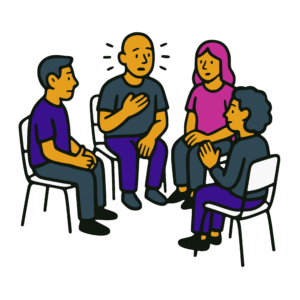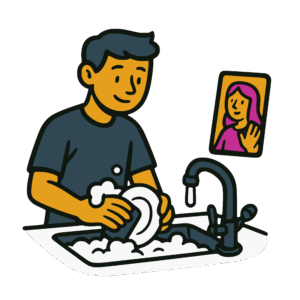As a teacher, I’m always on the lookout for powerful tools and principles that can transform the way artists and individuals grow. Surprisingly, many of these insights came from my personal journey through addiction recovery, particularly regarding safe emotional environments and active listening. The idea of “Dishwasher Mode,” a term I casually coined, originated from my experiences in a 12-step recovery group.
Origins in 12-Step Recovery
One crucial rule in such groups is to avoid “cross-talk,” which includes anything that hinders open and free sharing, like interruptions or distractions. Creating a space where people in recovery can express themselves without fear of invalidation is essential. Everyone has the right to share their thoughts and feelings without being interrupted or invalidated.

I’m reminded of the example set by Job’s three friends (before they undid all their good work by opening their mouths!):
Now when Job’s three friends heard of all this adversity that had come upon him, each one came from his own place (…) For they had made an appointment together to come and mourn with him, and to comfort him. (…) So they sat down with him on the ground seven days and seven nights, and no one spoke a word to him, for they saw that his grief was very great.
Job 2:11, 13
Incredibly, showing up for just 5–10 minutes every week on Friday nights to this practice was life-changing for me. Over the course of a year, my mindset underwent a dramatic shift. Experientially, I learned that my deepest and darkest thoughts and feelings, which I once considered shameful, didn’t disqualify me from meaningful relationships as I always feared. Fear’s power was dispelled, and emotional barriers were broken down.
Relationship Implications
The impact of Dishwasher Mode extended to my personal relationships, especially with my close ones like family and friends. The name itself was born during a conversation with an old friend who was continents away from me at the time.

Separated by distance, I found myself washing dishes while video chatting on WhatsApp. To avoid disrupting our conversation with the sensitive mic on my headphones, I muted myself and just listened. This unplanned practice allowed my friend to speak openly without the “back-and-forth” constraints of a typical conversation.
The freedom of expression in this “dishwasher mode” was truly liberating. As soon as it concluded, half an hour later, she happily exclaimed, “Wow… I like Dishwasher Mode!” It led to an honest and empowering monologue, where she shared things that unexpectedly affirmed me: private thoughts she had never voiced before, joyful moments about us she had shared with her friends, and the concerns she was experiencing about the uncertain future.
Dishwasher Mode for Artists
Remember the fear I mentioned earlier? Fear and anxiety also hinder our development as artists. So, Dishwasher Mode holds exciting potential for us too. I first realized this during an enlightening dinner conversation with my talented actor/musician friend, Michael.
We identified two types of performances in an artist support group or collective: 1) those seeking constructive feedback and 2) those engaging in “show-and-tell.” The latter resonated with the ethos of Dishwasher Mode, offering artists the opportunity to share their work without seeking critique. It’s a safe space to freely express their creations without the pressure of public opinion, whether it’s something they’ve been practicing in their own time or a small song they wrote late the night before.

Receiving feedback teaches us humility and reminds us that the quest for excellence is an ongoing process. On the other hand, sharing without feedback boosts confidence and provides crucial emotional support for the demanding yet rewarding journey ahead. Like James wrote in the context of enduring through difficult trials: we should be “swift to hear, slow to speak, slow to wrath” (James 1:19).
So, our goal isn’t to favor one type over another—both are valuable for our development, but for different reasons. The problem arises when we unconsciously conflate the two. Being mindful of their distinct benefits and practicing the art of discerning between them is essential for utilizing them effectively.
Creating intentional spaces for artists to participate in these “show-and-tell” sessions empowers them to transcend the fear of judgment or criticism. By regularly disconnecting performances from others’ opinions, artists can build confidence and develop their unique artistic personas. Moreover, this approach fosters a supportive environment where artists can inspire and uplift one another on their creative journeys.
Application
As I wrap up, here are a few practical tips to help you engage in your own artistic development or that of other creatives:
- Say thanks and be quiet. Simply say, “Thank you for sharing,” and let it sink in. Resist the urge to fill the silence and allow the moment to resonate. A hug or a high-five is also a great way to respond to their show-and-tell.
- Make time for it. Just like any other practice, it becomes real when it’s scheduled on the calendar. Be intentional and actively encourage your friends to embrace dishwasher mode. Doing so will help build an open and supportive relationship, which is crucial for their efficient growth.
- Create your own personal terminology. Instead of using my words, find unique ways to describe this concept in your life. Keep things fresh and special by adding your personal touch.

Just as my friend and I grew closer through that serendipitous video call situation, your relationships with other artists can be nurtured by embracing “Dishwasher Mode” as a regular practice. This approach promotes genuine connections, overcomes fear, and nurtures creativity. Embrace the freedom of Dishwasher Mode and embark on a journey of self-discovery and artistic fulfillment.


